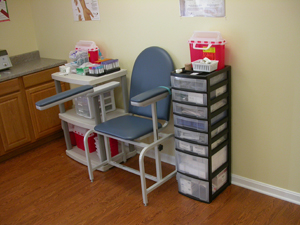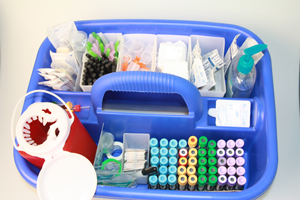Is Your Draw Station Designed for Safety?
There's much to consider in a safe outpatient environment
by Dennis Ernst • January 13, 2020

Too often outpatient draw stations are designed for looks, convenience, or available space rather than the safety of the patient or collector. Are your draw stations designed for your convenience at the expense of your patients' safety? Take a look at them with fresh eyes and consider how their layout, design, and furnishings may be inviting a preventable incident or injury.
Designing drawing rooms with the input of phlebotomists and others who use them afford the collector with the safest drawing environment possible. But there's one more critical source to consult: the industry standards for draw stations. Are your draw stations compliant or a liability? Do they work for or against your patients? Do they invite or prevent injuries and accidents? Use this checklist to see how you can improve your outpatient drawing environments and limit your legal liability.
- Arm rests. Do all of your outpatient drawing chairs have armrests? They should. According to the Clinical and Laboratory Standard Institute's venipuncture standard (GP41-A7), side armrests are required to prevent accidental falls should the patient lose consciousness.(1) If you draw from patients seated in chairs without armrests, discontinue the practice today. Replace unacceptable chairs with those that have at least two armrests, one on each side. Although not required, a third barrier that locks in place in front of the patient provides even more protection.
If you draw patients sitting upright on a hospital bed or exam table, have them recline to a recumbent position instead. Drawing patients who are sitting upright on tables, hospital beds, or cots fails to meet the standard, and creates a dangerous situation should they lose consciousness. Statistics show that up to five percent of patients pass out during or immediately following a venipuncture. Unfortunately, they don't come with warning signs. The standards also require patients with a history of fainting be recumbent during the draw. This is not negotiable, not even if the patient refuses to recline.
It is not advisable to ask patients if they've ever fainted. Studies show the mere mention of the word "faint" doubles the likelihood that they'll pass out during or following the draw. Instead, inquire if they've ever had any "problems" with prior blood draws. - Reclining chair, cot or gurney. If your outpatient phlebotomy chairs don't recline, is there a bed, cot, or gurney nearby for patients who need to lie down during the draw? If not, how are you complying with the CLSI requirement for patients who tell you they have a history of passing out during a blood draw? What about a patient who needs to be restrained for whatever reason? Having reclining phlebotomy chairs in every draw station or a place for patients to lay is not only a good idea, it's good risk management.
- The layout. Being fully prepared means not only seating patients in chairs with armrests or reclining them, but being vigilant at all times. This means not turning your back on the patient or distancing yourself from them so that you cannot react in a timely manner. If your supplies are more than an arm's reach from the patient, you are creating at least two potential problems, both of which put the patient at risk. First, should you need another tube the room's layout puts you in a precarious position. You may well have to terminate the puncture and repeat the procedure resulting in an inconvenience to the patient, the loss of confidence from the patient, and your own lost productivity. Even worse, you may be tempted to stretch to such an extreme degree that the needle within the patient's arm lacerates tissues and structures beneath the skin. Both of these options are undesirable.
- Secondly, if the area is designed in such a way that requires the collector to leave the side of the patient to label the tube or discard of the needle, the collector is no longer able to react in a timely manner should the patient lose consciousness. Without being within arm's reach, a patient can quickly pass out, fall from the chair and suffer injuries. Being vigilant means being within arm's reach of the patient until he/she is released from your care.
- Ammonia inhalants. Do you have ammonia inhalants within reach of the draw chair? If so, remove them. CLSI doesn't permit their use on patients who get dizzy or pass out due to the risk that they may be asthmatic. If so, and you use ammonia to revive them, you may trigger an asthmatic attack.
- Squeeze toys. Do your draw stations have rubber balls or other devices patients can squeeze to make their veins more visible? If so, get rid of them before one of your patients is treated according to a falsely elevated potassium level. Fist pumping has been shown to increase potassium levels up to 2.7 mmol/L.(2) Have your patients clench and hold their fists, but only when necessary. Never ask patients to pump the fist if the blood you are drawing will be tested for potassium. If fist pumping is required to locate a suitable vein, release the tourniquet after finding the vein and allow two minutes to pass before reapplying constriction. This will allow the blood in the limb to return to its basal state.

- Being well-stocked. Do your draw stations include a wide variety of tube sizes? They should. If you limit the volume of tubes accessible, you limit your potential to draw the difficult patient successfully. Should the patient's vein collapse under the excessive pressure a large-volume tube exerts, a well-stocked collection of supplies will permit you to remove the slowly filling tube from the tube holder and replace it with a smaller tube with lesser vacuum. The ultimate objective is to submit full tubes to the laboratory so that the tests aren't affected by an excessive concentration of additive. Since some patients prove to be unpredictably difficult to fill large-volume tubes from, an ample supply of smaller tubes might save you both from a second attempt.
- Sharps containers within reach. Draw station safety isn't just about the patient. Protecting the collector should take equal priority. If the sharps container is not within reach of the point of use, the area isn't engineered for exposure prevention a well as it could be. According to OSHA's Bloodborne Pathogens Standard, a sharps container must be "as close as is feasible to the immediate area where sharps are used...." Having to carry a contaminated sharp across the room, or from one room to another, increases the window of vulnerability a healthcare worker has to an exposure.(3) Even if the sharp is concealed by a safety feature that was activated immediately, its disposal should be just as immediate. According to OSHA's Compliance Directive (the document it issues to inspectors in the field to interpret and enforce the standard) "if an employee must travel to a remote location to discard a sharp, it will increase the possibility of an accidental needlestick and increase the chances that needles and sharps will be improperly discarded and create potential hazards for other staff members."(4)
- Call button. Is there a mechanism for phlebotomists or other specimen collection personnel to call for help should a routine draw develop complications? Call buttons or assist lights are good ideas for draw stations that may be remote to other personnel who may be needed during emergencies.
- A clean well-lit place. Don't underestimate the importance of good lighting that can facilitate an uneventful draw. Often lighting is the least-considered factor when designing or reevaluating draw stations. However, specimen collection personnel operating under good lighting conditions likely have fewer complicated draws. In addition, a well-lit drawing area can give the patient the impression that he/she is in a cleaner, more professional facility than one that is dimly lit and shadowy.
- Sink for handwashing. Do your draw stations permit easy compliance with the prevailing recommendations on handwashing? OSHA and the Centers for Disease Control and Prevention (CDC) require that collectors perform hand hygiene immediately or as soon as feasible after gloves or other personal protective equipment are removed.(3,5) While the use of hand gels are acceptable, soap and water are required if the hands are visibly soiled with blood or other potentially infectious material or if the patient is known to be infected with spore-forming bacteria such as B. anthracis or C. difficile. Therefore, a handwashing sink must be accessible.
- Housekeeping. It’s the employer’s responsibility to ensure the work site is maintained in a clean and sanitary condition. A well designed draw station means materials used are of such a nature that they can be regularly cleaned and decontaminated. Carpet, porous surfaces, and cloth chairs provide a considerable challenge to maintaining a sanitary environment. If your draw station is carpeted, contaminated areas should be easily and readily replaced.

- Did you hear that? Is your drawing area in a dedicated room or is it incorporated into other areas? Without a dedicated area for specimen collection, facilities run the risk of trampling on their patient's privacy rights. When a patient interaction is overheard by other employees or visitors, confidential information may be inadvertently passed on, which can be a violation of the Health Insurance Portability and Accountability Act (HIPAA). Safety includes protecting a patient's right to privacy.
- Elbow room. Another potential problem of incorporating a drawing station into areas used for other purposes is the effect that traffic can have on the procedure. Make sure your drawing area is well away from those who might pass by and accidentally bump a collector trying to steady a needle within someone's vein.
Whether you're a manager, safety officer, or phlebotomist, take a walk around your outpatient drawing areas with new eyes as soon as possible. Consider the list above to be your checklist for safety, compliance and risk management and make any changes as soon as possible. If changes require a significant redesign, expedite a renovation. Most of the items mentioned in this article are more than a matter of convenience and must be addressed if your facility is to be safe, patient-friendly and standard-compliant.
Editor's Note: CLSI requirements and recommendations for draw stations are included in Standard GP41-A7, accessible from CLSI or the Center from Phlebotomy Education's "Standards" page.
References:
1) CLSI. Collection of Diagnostic Venous Blood Specimens; Approved Standard—Seventh Edition. CLSI document GP41-A7. Wayne, PA: Clinical and Laboratory Standards Institute; 2017.
2) Narayanan S. The preanalytic phase an important component of laboratory testing. Am J Clin Pathol 2000;113:429-452.
3) Occupational Safety and Health Administration. (1991) Occupational exposure to bloodborne pathogens: Final rule. 29 CFR 1910.1030. Federal Register, 56, 64003-64282.
4) Enforcement Procedures for the Occupational Exposure to Bloodborne Pathogens http://www.osha.gov/pls/oshaweb/owadisp.show_document?p_table=DIRECTIVES&p_id=2570. Accessed 2/18/08.
5) Centers for Disease Control and Prevention. Guideline for Hand Hygiene in Healthcare Settings. https://www.cdc.gov/handhygiene/providers/guideline.html. Accessed 1/8/2020.
Related Posts and Information
overall rating: my rating: log in to rate
YouTube chair draw station outpatient positioning
